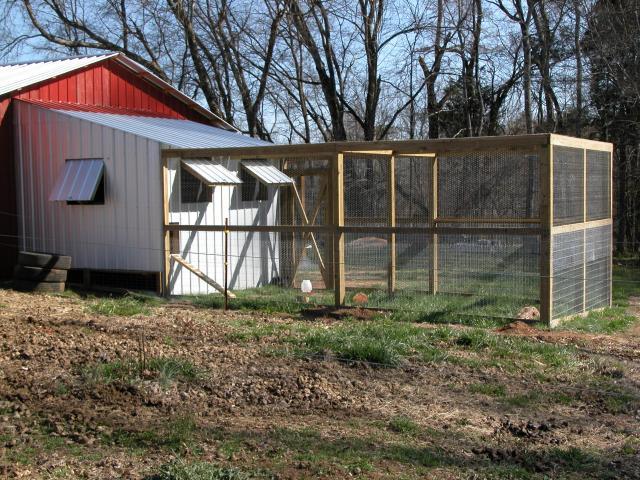I'm nearing the end of my coop building phase, and I'm pretty darn impressed with my 99% solo work on it (husband was available for 1% of work due to his overtime hours getting in the way of coop building!). My girls have NOT spent a night yet, although we're close to that phase.
However, I've hit that point where I'm certainly nervous for their well-being due to my fledgling coop building skills. I look over my coop and question security, not necessarily because of my techniques, but just the reality of determined predators. I had to laugh grimly to myself when I already found raccoon tracks on the roof of the coop!
My coop thus far:
*elevated
*3/4" plywood, windows covered in HC cloth
* swivel hasps on doors with accompanying locks
* Dutch door to run, each half has a swivel hasp, plus adding some sort of bolt slide/hook eye closure/something at the lower corner edge so predator can't pry bottom part of door open.
* fender washers/screw combo every 8-15 " for HC cloth (unless it lower down or on windows, then I added more washer/screws)
* 1 ft vertical wood running along base perimeter of run/coop, both to hold in the sand and sandwiching HC cloth between two pieces of wood
* guillotine pop door, no bottom exposure of door so greedy paws can't pull out door or slide it up.
* Enclosed/roofed run, 19 gauge HC cloth with 2 ft "apron" extending outwards. Semi fenced floor of run (it was leftover garden fencing I
just threw down just because I had it)
* flagstones placed on edges of HC cloth apron, to conceal edging
* r-panel metal roofing, need to seal up smaller openings with HC so snakes/weasels can't squeeze through the areas where the ridging doesn't quite meet the wood
*exterior nest box with both locking hasp, and hook closure.
I plan on locking my girls up every night....it gets wicked hot here in Texas, but I think I have decent ventilation, hopefully well protected by HC since windows will be wide open. I'd like to think it's pretty fortified, but I get the willies thinking that a predator has ALL night to work on a weak spot on my coop. I'd like to consider electric fencing, but I'm not sure about the expenditure, or if it's semi useless since a raccoon can hop over my single strand to climb?
Anyhow, I'm looking forward to hearing what you consider the strong points of your coop....mine hasn't been fielded tested yet so I'm curious to know how your design/idea etc have kept your flock safe!
*
However, I've hit that point where I'm certainly nervous for their well-being due to my fledgling coop building skills. I look over my coop and question security, not necessarily because of my techniques, but just the reality of determined predators. I had to laugh grimly to myself when I already found raccoon tracks on the roof of the coop!
My coop thus far:
*elevated
*3/4" plywood, windows covered in HC cloth
* swivel hasps on doors with accompanying locks
* Dutch door to run, each half has a swivel hasp, plus adding some sort of bolt slide/hook eye closure/something at the lower corner edge so predator can't pry bottom part of door open.
* fender washers/screw combo every 8-15 " for HC cloth (unless it lower down or on windows, then I added more washer/screws)
* 1 ft vertical wood running along base perimeter of run/coop, both to hold in the sand and sandwiching HC cloth between two pieces of wood
* guillotine pop door, no bottom exposure of door so greedy paws can't pull out door or slide it up.
* Enclosed/roofed run, 19 gauge HC cloth with 2 ft "apron" extending outwards. Semi fenced floor of run (it was leftover garden fencing I
just threw down just because I had it)
* flagstones placed on edges of HC cloth apron, to conceal edging
* r-panel metal roofing, need to seal up smaller openings with HC so snakes/weasels can't squeeze through the areas where the ridging doesn't quite meet the wood
*exterior nest box with both locking hasp, and hook closure.
I plan on locking my girls up every night....it gets wicked hot here in Texas, but I think I have decent ventilation, hopefully well protected by HC since windows will be wide open. I'd like to think it's pretty fortified, but I get the willies thinking that a predator has ALL night to work on a weak spot on my coop. I'd like to consider electric fencing, but I'm not sure about the expenditure, or if it's semi useless since a raccoon can hop over my single strand to climb?
Anyhow, I'm looking forward to hearing what you consider the strong points of your coop....mine hasn't been fielded tested yet so I'm curious to know how your design/idea etc have kept your flock safe!
*
Last edited:









